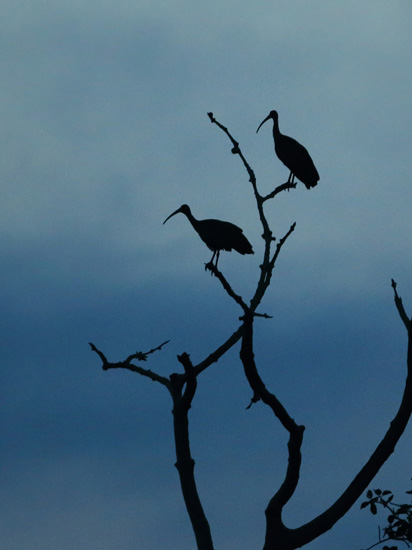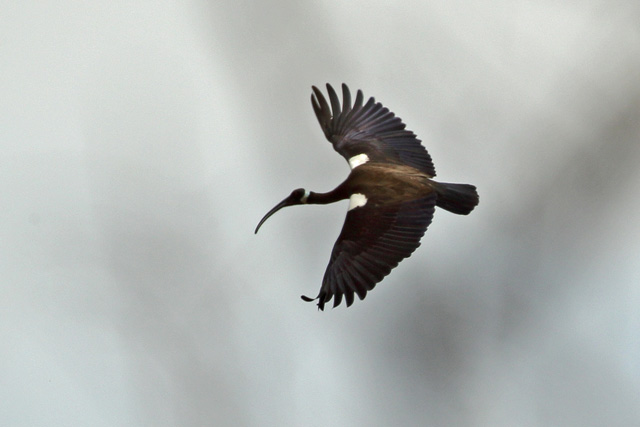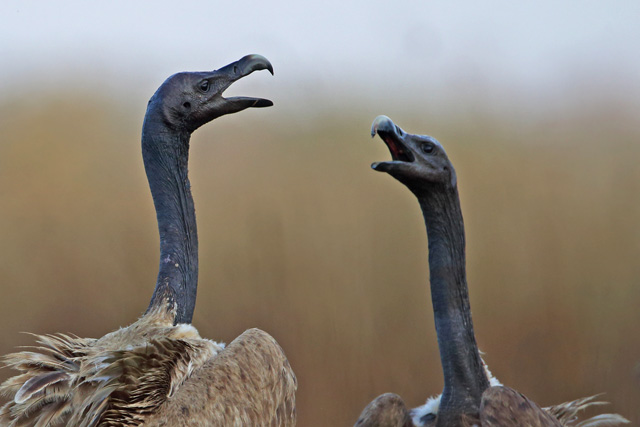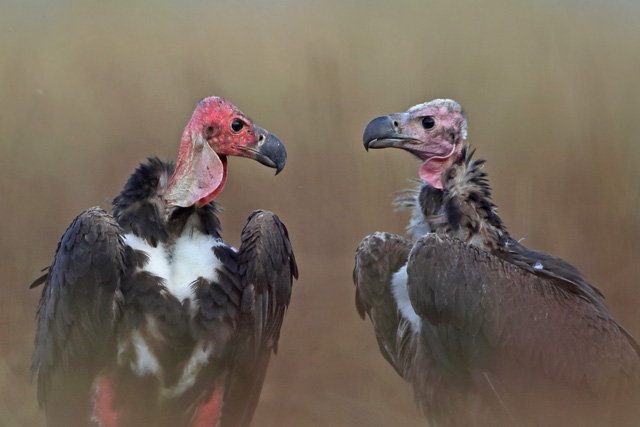Cambodia is a superb destination for anyone with an interest in oriental birding. Its still-large (though much reduced) tracts of forest support hundreds of breeding species — from raptors to fantails, woodshrikes to woodpeckers — while freshwater lakes such as Tonle Sap support large populations of waterbirds. Above all, the country is home to an extraordinary number of endangered (some critically) and limited-range birds. On a recent trip with two friends, Neil Bowman and David Watson, I was blown away by two things: the quality of the birding, and the imaginative efforts to engage village communities in the conservation of their birds.
Giant Ibis
Imagine the scene. It is pre-dawn on the country's Northern Plains. At 05:45, we can be found walking in the dark through an area of open-canopy forest near the village of Prey Veng. We are here for one reason: hoping to see one of the world's rarest birds at roost. Our two guides — one from the local village and Sophoan Sanh from the Sam Veasna Centre in Siem Reap — signal for us to stop. Words aren't necessary. We know we have arrived. Now it is just a question of waiting silently for first light — and hoping for the best...
In time, the silhouette of a distant tree became imprinted on the lightening eastern sky, and on its upper branches were two Giant Ibis. Although it was impossible to make out details of their plumage we could see their long decurved bills, long legs and huge size. We were then treated to a tremendously evocative experience as they began to call, initiating a response from a third (unseen) bird. After a few minutes all three flew off for a day's feeding. Although we were to have better views a couple of days later it is this memory that will remain with me forever.

Giant Ibis, Cambodia (Photo: Neil Bowman)
Giant Ibis is Cambodia's national bird. Now extinct in most of its former range, it has been reduced to two core areas on the Northern Plains. Recent survey figures put its breeding population at just 115 pairs, with a world population of maybe 345 individuals. The odds certainly seem stacked against it. Giant Ibis has suffered from hunting, deforestation and disturbance. In the dry season it feeds in the mud of waterholes, which in the past were maintained by large wild mammals. The dramatic reduction of the mammalian megafauna has seen many of these feeding places dry out, so creating another problem. But there is hope...
Ibis Rice
Among a number of creative conservation initiatives undertaken by the Sam Veasna Centre, the Wildlife Conservation Society's Cambodian partner, is the Ibis Rice project. Farmers grow this rice in the forest where Giant Ibis and its critically endangered near-relative White-shouldered Ibis breed and feed. In exchange for neither hunting the birds nor clearing the forest, village farmers are offered training to increase their rice yields organically. Their rice is marketed and the farmers receive a premium price for it. Additionally, visitors pay to see and photograph the birds, their cash going directly to village committees for projects ranging from wells to schools. Villagers are also trained to become wildlife guides. With a growing human population in the dry dipterocarp forest where the ibis live, there are still huge land-use pressures, but more families are signing up to the Ibis Rice project and there are indications that the birds' numbers are responding positively.

White-shouldered Ibis, Cambodia (Photo: Neil Bowman)
A vulture restaurant
Turning the clock forward a couple of days we are to be found a little further to the east, just outside the village of Veal Krous, and sitting in a covered trench in the pre-dawn darkness. Beside me, Neil crouches behind his enormous lens, waiting for the first indications of a new day. The odour of rotting flesh wafts through the screen in front of us — not too bad but enough to remind us that the previous day a cow's carcass was dumped on the ground a few metres away. Time moves slowly. We speak not a word, however, since silence is all-important.
Just after 06:00, the 'whoosh' of a very large bird passes directly overhead and is followed by some flapping and an evil-sounding hiss. I risk parting the reedy screen a few centimetres and notice that the sky has lightened by a few degrees, revealing the silhouettes of several vultures in the top of a tree. Much closer, several of these giants are already jostling with each other on the ground, just 30 metres away. I've never had a problem watching others eat but this is very special. The vultures spent yesterday afternoon investigating how best to gain access to the deceased bovine's best joints. Clearly that is no longer an issue since the animal has been reduced to a pile of bones and offal.
As the sun comes up over this corner of dipterocarp forest in northern Cambodia, the diners' identities are revealed. Most are White-rumped Vultures but there are also a handful of Red-headed Vultures with their strangely perplexed expressions. The latter seem to spend most of their time standing around, doing very little, but they are clearly one step up in the pecking order. Then there are the Slender-billed Vultures with their black, snake-like necks, perfect for going deep inside any dead animal. It is quickly clear that they always get what they want. The others back away when the Slender-bills hiss out a warning. Screams, hisses and the sound of wings flapping...this is the accompaniment to the endgame as bones are stripped of their last morsels of flesh.

Slender-billed Vulture, Cambodia (Photo: Neil Bowman)
Apart from their love of carrion, these vultures are sadly united by one thing: their extreme rarity. The 60-odd birds we are watching represent a significant proportion of the world's population of each species. All are classified as Critically Endangered, and extinction is now a real threat. It was not always so but vulture populations have crashed catastrophically since the 1990s, down by as much as 99%, due to the treatment of cattle with Diclofenac. Those populations that remain are now disjointed.

Red-headed Vulture, Cambodia (Photo: Neil Bowman)
The drug was never used in Cambodia and only on the Northern Plains of that country are the vultures just about holding their own, thanks largely to a series of 'vulture restaurants' established by the Sam Veasna team. Here, villagers are paid to slaughter a geriatric cow on a regular basis to provide a supplementary food source. As with the ibis, visiting birders and photographers pay for the privilege of witnessing the vultures. In return, the villagers provide the carrion, feed and guide visitors, maintain the hides and provide tented accommodation. So families gain extra income, the community is actively involved in conservation — and birders have a lot of fun. Everyone benefits. This is a magnificent model for sustainable conservation and ecotourism, and one that could be successfully adopted elsewhere.
If you've never thought about visiting Cambodia, why not take a look at the Sam Veasna website at www.samveasna.org to see it for yourself.

